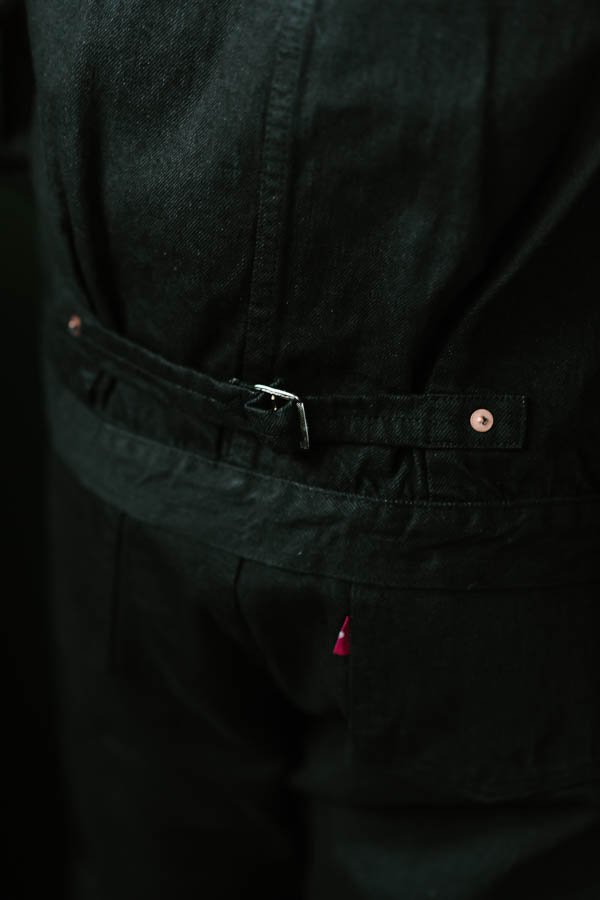Two Cats Brand Black x Black Collection
You may be asking yourself why Two Cat's Brand (TCB) is so special. Well, beyond all the obvious details, there's a story. This is a brand that truly does what they love. Most things have a rhyme and reason, but sometimes they just create what suits their needs. The vintage, reproduction inspiration behind the brand is clearly visible. They're honoring styles from the '30s-'60s with a few items dating pre-1900's. Sometimes they create fantasy or future (e.g. present) cuts that didn't exist in the past, but the bulk of their work is true reproduction. That's what we went with on this round. You may also be asking, why such a low price compared to other Japanese brands. This is due to the fact that everything besides the milling of the fabric is done in-house. There is no outsourcing for cutting or sewing. In Kojima, the denim capital of Japan sits their vertically integrated factory where they do: fabric cutting, single stitch sewing, lapping seam sewing, applying buttons and rivets, and much, much more. We are so excited to introduce you to TCB.
TCB S40 Jeans Black x Black
The best part of this denim, a reproduction of the 501xx, is all the minute details you wouldn't notice unless you had fully researched the original pairs. The first one is basically the entirety of the back pockets. To start, there are hidden rivets. You'll notice a wonky curve on the inner pocket stitch as it gets closer to the rivets. TCB's best guess is that this was done by a less skilled seamstress who wanted to give plenty of tolerance as to not hit the hidden rivets. Then, you'll notice on the bottom left of the back left pocket a stitch that overruns the edge of the pocket. This, by TCB's standards, would be a defect, and they would normally redo it. But, in this instance, they did it to mimic the original pair. On the right pocket you'll notice a tiny monkey stitch on the inner stitch.
Next, you'll scope the belt loop details. On the WW2 pair, the belt loop starts with a bit of a gap from the top of the waistband. You'll also notice that the loops are a little wider, but the dual stitch runs with a narrow pattern. The space between the center stitch is filled, so it will fade very nicely as well.
There are also some subtle details on the inside of the denim that parallels how the originals were done. On the right side of the denim, they used a single stitch with a yarn count thread of 6. On the left side, they used a chain stitch. Again, a mystery to TCB, but in order to reproduce these to their fullest, you'll find it in your pair as well.
The fabric is a 14oz denim, that after careful examination of the original was mimicked by using EMOT Cotton (Eastern Memphis, New Orleans, and Texas). This style of denim uses hard twisted, slubby yarns which allow the dye to only penetrate so far into the cotton during rope dying. This will be extremely important when fading as to achieve that vintage look. Nowadays, people want a deeper whiteness to the core of the denim for purity. For this pair, and many of their other repros, they focus on keeping the core of the denim a more natural creamy color. All of this is woven on Toyoda shuttle looms in Kojima.
(You may notice all the details are the same for this pair. That's because it's built just like the indigo s40's with a black x black weft.)
TCB S40 Jacket Black x Black
This jacket has all the dressings of the s40's jeans. It's kind of a lovely mess. The beauty in the S40's line is in the imperfections - details that only existed because of the impact of WW2. To start, you'll notice that the box pleats are misaligned. This detail is true to original and believed to be a product of two different seamstresses working on each side. On the cuff, you'll notice the outer stitch doesn't quite line up with the placket. It comes up about 3/4". They're not sure why this happened...most likely due to less skilled seamstresses. Whatever the case, they've reproduced it. The back cinch is cut in a square or rectangular style and features what they're calling a sketchy stitch. Again, all true to the original piece. The red tab is also higher on the pocket with these. And lastly, the unfinished steel buttons weren't common until WW2. No one wanted rusty buttons back then, but copper and nickel were banned from use. Alas, you'll have some buttons that patina like crazy. It's quite wonderful that TCB and their customers find the beauty in imperfection and the perfection it takes to create it.
The fabric is a 14oz denim, that after careful examination of the original was mimicked by using EMOT Cotton (Eastern Memphis, New Orleans, and Texas). This style of denim uses hard twisted, slubby yarns which allow the dye to only penetrate so far into the cotton during rope dying. This will be extremely important when fading as to achieve that vintage look. Nowadays, people want a deeper whiteness to the core of the denim for purity. For this jacket, and many of their other repros, they focus on keeping the core of the denim a more natural creamy color. All of this is woven on Toyoda shuttle looms in Kojima.





































